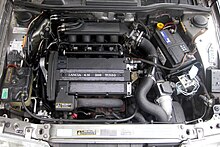Aurelio Lampredi

Aurelio Lampredi (born June 16, 1917 in Livorno ; † June 1, 1989 ibid) was an Italian designer of automobile and aircraft engines.
Professional background
Lampredi began his career before World War II . He worked at Piaggio , Isotta Fraschini and later for Reggiane as a designer of aircraft engines.
After the war he became known far beyond the borders of Italy as a designer of 12-cylinder engines for Scuderia Ferrari . Lampredi had already built an engine for Ferrari in 1946. This 4.5-liter V12 engine was used in the Ferrari 275S from 1950. Lampredi returned to Isotta Fraschini for a year in 1947, and from 1948 onwards he began to implement his concept of engines without supercharging at Ferrari.
The new engines played a key role in Ferrari's first successes in Formula 1 . Initially, the engines were installed in the 275F1 and 340F1 , before José Froilán González celebrated Ferrari's first victory in a world championship race in the Ferrari 375F1 with a Lampredi V12 engine at the 1951 British Grand Prix in Silverstone .
When in 1952 the rules for the races in the largest monoposto class changed, Aurelio Lampredi designed a new engine. He developed a 4-cylinder engine with a displacement of 2 liters for the races of the drivers' world championship, which are now based on the technical regulations of Formula 2 . The engine was used in the new Ferrari 500 with which Alberto Ascari won the world championships in 1952 and 1953.
Lampredi's work for Ferrari ended in 1955 after he took over the racing division of Lancia . With Lancia, Vittorio Jano came to Ferrari and its V6 and V8 engines in Ferrari racing cars. However, the Lampredi 12-cylinder engines lived on and were used in road cars for many years. Lampredi himself switched to Fiat , where he was chief developer in the engine department until 1977. From 1973 to 1982 he was also the sports director of the Fiat subsidiary Abarth .
Lampredi was responsible for the Fiat Twin Cam and SOHC engines, which he continuously developed. The so-called Lampredi engine was built, first as an 8V engine and later as a 2-liter 16V engine, until the late 1990s. In 1982 this type of engine, as a 16V turbo version in the Lancia LC racing car, achieved 450 hp from a 1.4 liter displacement. The most powerful production vehicles with a Fiat twin-cam engine were the Lancia S4 (1985) and the Lancia Hyena (1992), each with 250 hp.
Web links
- Photo: Aurelio Lampredi (center) with Enzo Ferrari (right)
- About the Lampredi engine
- Aurelio Lampredi at motorsportmemorial.org (English)
| personal data | |
|---|---|
| SURNAME | Lampredi, Aurelio |
| BRIEF DESCRIPTION | Italian designer |
| DATE OF BIRTH | June 16, 1917 |
| PLACE OF BIRTH | Livorno |
| DATE OF DEATH | June 1, 1989 |
| Place of death | Livorno |

